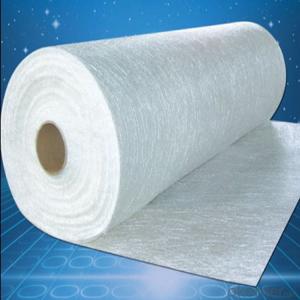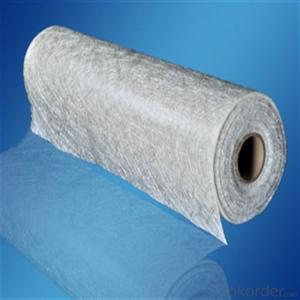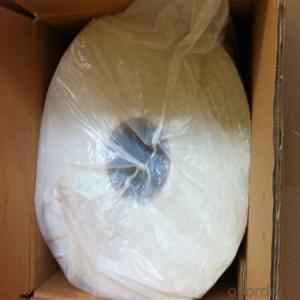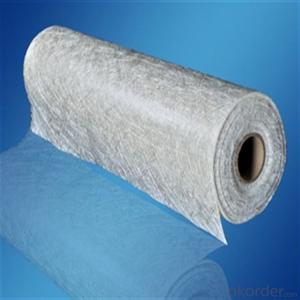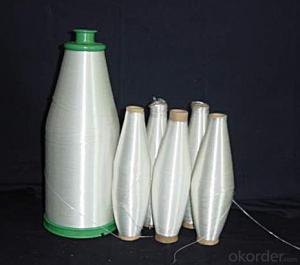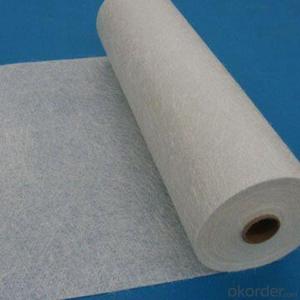Fiberglass Emulsion Chop Strand Mat
- Loading Port:
- China main port
- Payment Terms:
- TT OR LC
- Min Order Qty:
- 1 kg
- Supply Capability:
- 5000 kg/month
OKorder Service Pledge
OKorder Financial Service
You Might Also Like
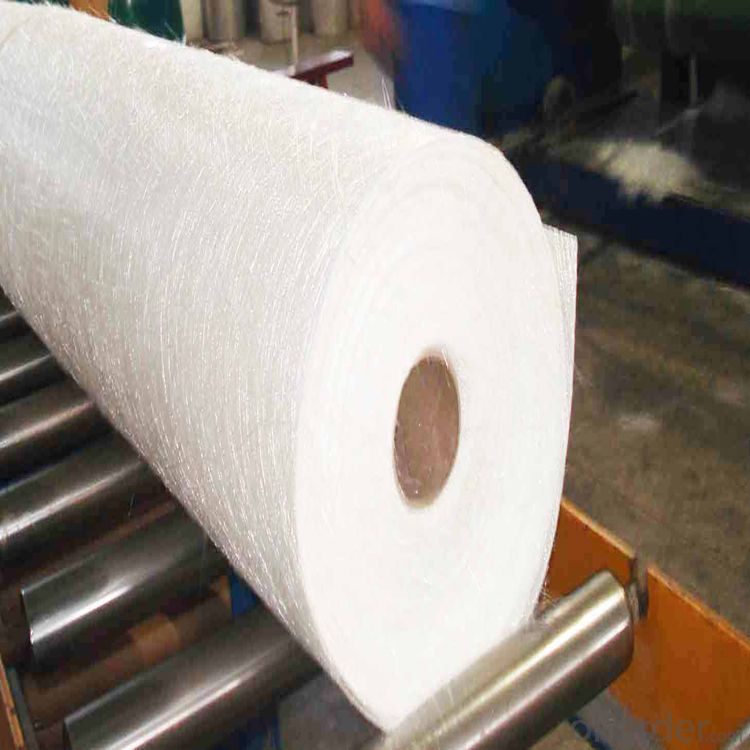
Product Description:
Chopped strand mat is made from chopped glass fibers, which are bonded with powder or emulsion binders. It can be used in hand lay-up process and continuous laminating process to produce FRP products, such as plates, lighting board, hull, bathtub, cooling towers, anti-corrosion materials, vehicles.
Features:
Uniform thickness, softness and hardness good.
Good compatibility with resin, easy completely wet-out.
Fast and consistent wet-out speed in resins and good manufacturability.
Good mechanical properties, easy cutting.
Good cover mold, suitable for modeling complex shapes.
Application:
fiberglass thickness is suitable for application by hand lay-up, reinforce and machine FRP molding,
including interior decoration of vehicles, boat hulls, complete set of sanitary equipment, anticorrosive pipes, tanks, building materials, tables, chairs, panels and all kind of composite FRP products.
Specifications:
Item | Over Density | Moisture Content | Chop Density | Polyester Yarn | Width |
(g/m2) | (%) | (g/m2) | (g/m2) | (mm) | |
EMK300 | 309.5 | ≤0.15 | 300 | 9.5 | 50-3300 |
EMK380 | 399 | 380 | 19 | ||
EMK450 | 459.5 | 450 | 9.5 | ||
EMK450 | 469 | 450 | 19 | ||
EMC0020 | 620.9 | 601.9 | 19 | ||
EMC0030 | 909.5 | 900 | 9.5 |
Special products are available according to customer’s requirement.
Product Packaging:
Each Surface Tissue is wound onto a paper tube which has an inside diameter of 76mm and the mat roll has a diameter of 330mm. The mat roll is wrapped up with plastic film,and then packed in a cardboard box or wrapped up with kraft paper. The rolls can be vertically or horizontally placed. For transportation, the rolls can be loaded into a cantainer directly or on pallets.
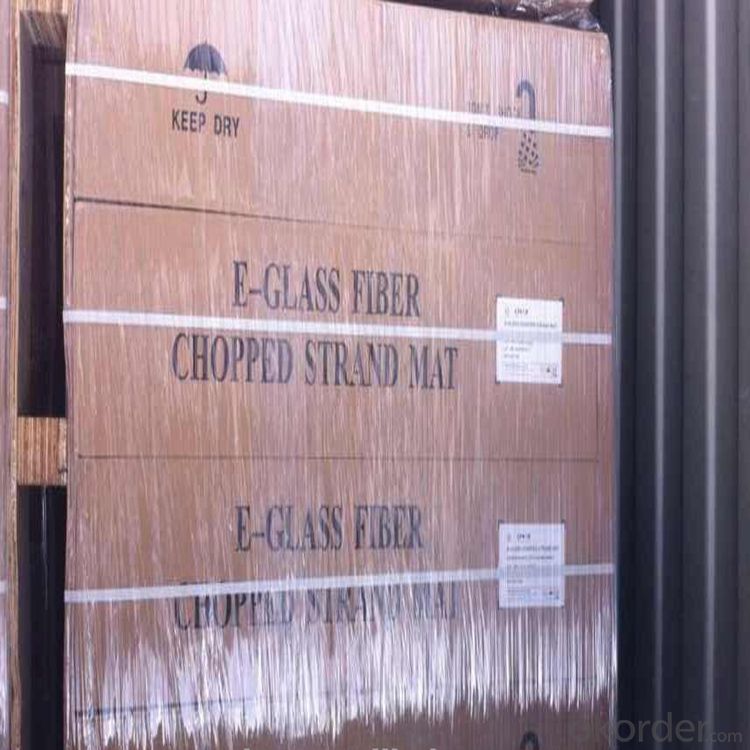
Product Storage:
Unless otherwise specified, Chopped Strand Mat should be stored in a dry, cool and rain-proof area. It is recommended that the room temperature and humidity should be always maintained at 15℃~35℃ and 50%~75% respectively.
Company Information
CNBM (China National Building Material) Group is the largest comprehensive building materials group in China that in integrate scientific research, manufacturing and logistics into one entity. The largest building materials and equipment specialists in China. Upon State Council approval, today CNBM owned more than 300 subordinate manufacturing factories and servicing companies. There are 6 fully owned public listed companies and 11 partially owned with substantial shares public listed companies. In many of these fields, CNBM is playing the leading role in the building industry in the country.

Order Information
Ordering please specify:
1. the product code, 2. weight, 3. width, 4. order quantity, 5. packaging, 6. special requirements please specify.
FAQ:
1. How long will you get reply?
Any inquiry will be replied within 24 hours. Usually we will reply within 12 hours.
2. How long is warranty period?
We provide 3 year warranty period.
3. What is your MOQ?
Any order quantity is available.
4. Can you provide sample?
Yes, samples are in stock. we can offer free sample for you.
5. Payment terms?
We can accept L/C, T/T, Western Union, Paypal etc.
6. Do you offer OEM service?
Yes, we can print customers’ logo on the packaging;
And the size and specification can be produced and design according to your demand.
7. What is the Production Lead Time?
15-20 days for bulk production after confirm the order.
- Q:Can fiberglass chopped strand be used in electrical insulation?
- Fiberglass chopped strand is capable of being utilized for electrical insulation purposes. Due to its non-conductive nature, fiberglass does not allow for the transmission of electricity. Consequently, it can serve as an insulating material that obstructs the flow of electrical current. The chopped strand variant of fiberglass finds widespread application in the manufacturing of various electrical insulation components, including circuit boards, transformers, and electrical cables. It offers exceptional insulation properties, notable mechanical strength, and commendable resistance to thermal influences, rendering it a desirable option for electrical insulation applications. Furthermore, fiberglass chopped strand demonstrates resistance to chemicals, moisture, and temperature fluctuations, thereby further enhancing its aptitude for electrical insulation objectives.
- Q:How does the fiber surface treatment affect the performance of fiberglass chopped strand?
- Fiber surface treatment plays a crucial role in enhancing the performance of fiberglass chopped strand. The treatment involves applying a chemical coating on the surface of the fibers, which can significantly impact various properties of the fiberglass. Firstly, surface treatment improves the adhesion between the fiber and the matrix material in composite applications. The chemical coating enhances the compatibility between the fiber and the resin, allowing for better bonding and transfer of stress between the two components. This leads to improved mechanical properties, such as tensile strength, flexural strength, and impact resistance, as the load can be more effectively transferred from the matrix to the fibers. Secondly, surface treatment can also enhance the wetting ability of the fiber. By modifying the surface chemistry, the treatment allows for better wet-out of the fibers by the resin during the manufacturing process. This results in reduced void content and improved overall fiber-matrix interaction, leading to higher composite strength and stiffness. Additionally, surface treatment can improve the fiber's resistance to moisture and chemical degradation. The chemical coating acts as a protective layer, preventing water absorption and reducing the potential for degradation caused by exposure to harsh environments or chemicals. This improves the long-term durability and performance of fiberglass chopped strands in various applications, such as construction, automotive, and aerospace. Furthermore, surface treatment can also affect the fiber's dispersion and processability. The chemical coating can reduce fiber entanglement and improve the flowability of the chopped strands during processing, such as in injection molding or pultrusion. This results in improved processing efficiency and enhanced mechanical properties in the final product. In summary, fiber surface treatment significantly affects the performance of fiberglass chopped strand by enhancing adhesion, wetting ability, resistance to degradation, and processability. These improvements ultimately lead to stronger, more durable, and high-performance composite materials.
- Q:Can fiberglass chopped strand be used in the production of electrical circuit boards?
- No, fiberglass chopped strand is not typically used in the production of electrical circuit boards. Electrical circuit boards are usually made using a layered structure of non-conductive materials such as epoxy resin, copper foil, and fiberglass fabric. While fiberglass may be used as a reinforcement material in some circuit board designs, it is typically in the form of woven fabric or as part of a composite material rather than as chopped strands. The use of chopped strands in circuit board production is more common in other industries, such as automotive or construction.
- Q:What are the typical packaging options for fiberglass chopped strand?
- The typical packaging options for fiberglass chopped strand include bags, boxes, and pallets. Fiberglass chopped strand is generally packaged in bags made of plastic or paper, which are convenient for small quantities and easy to handle. These bags come in various sizes, ranging from a few kilograms to larger sizes for industrial applications. For larger quantities, fiberglass chopped strand can be packaged in boxes or cartons. These boxes are usually made of corrugated cardboard and provide additional protection during transportation and storage. They are commonly used for commercial or industrial purposes, where larger quantities of chopped strand are required. In some cases, fiberglass chopped strand can also be packaged on pallets. This option is suitable for bulk orders or when the product needs to be transported in large quantities. Pallets provide stability during handling and can be easily loaded onto trucks or shipping containers, making them suitable for long-distance transportation. Overall, the choice of packaging option for fiberglass chopped strand depends on the quantity, intended use, and transportation requirements.
- Q:How does the manufacturing process of fiberglass chopped strand impact its quality?
- The manufacturing process of fiberglass chopped strand plays a significant role in determining the quality of the final product. Several factors influence the quality of fiberglass chopped strand during the manufacturing process. Firstly, the selection of high-quality raw materials is crucial. The fiberglass used should be of premium quality and have consistent properties. The choice of resin used to bind the fibers together also affects the overall strength and durability of the chopped strand. The manufacturing process should involve proper cutting techniques to achieve the desired length of the chopped strand. The cutting process must be precise and uniform to ensure consistent quality throughout the product. Any inconsistency in the length of the strands can result in variations in strength and performance. The alignment of the fibers is another critical aspect. The manufacturing process should ensure that the fibers are properly dispersed and aligned in a consistent manner. This alignment affects the mechanical properties of the chopped strand, such as tensile strength and stiffness. The curing process is also essential in determining the quality of the final product. Adequate curing time and temperature should be maintained to ensure proper bonding of the fibers and resin. Insufficient or excessive curing can lead to weakened bonds and reduced performance. Furthermore, quality control measures should be in place throughout the manufacturing process. Regular testing and inspection of the chopped strand for various properties, such as tensile strength, moisture content, and fiber distribution, help identify any deviations from the desired quality standards. Overall, the manufacturing process of fiberglass chopped strand significantly impacts its quality. Proper selection of raw materials, precise cutting techniques, uniform fiber alignment, appropriate curing, and rigorous quality control measures all contribute to ensuring a high-quality final product.
- Q:How does the impact resistance of the chopped strand affect its performance?
- The overall performance of chopped strand is directly influenced by its impact resistance. Chopped strand is commonly utilized as a reinforcement material in different composite applications, providing strength and durability to the final product. The ability of chopped strand to withstand sudden force or impact without breaking or deforming is determined by its impact resistance. Having a higher impact resistance means that chopped strand can effectively absorb and dissipate energy when subjected to sudden impacts. This is especially important in applications where the composite material may encounter external forces, like automotive parts, sporting equipment, or construction materials. When chopped strand possesses low impact resistance, it becomes more prone to cracking, breaking, or delaminating under impact loads. This compromises the structural integrity of the final product, resulting in reduced performance and lifespan. Additionally, the chopped strand may fail to provide the required reinforcement, making the product more vulnerable to damage. On the flip side, a higher impact resistance enhances the performance and durability of the composite material. It enables chopped strand to efficiently absorb and distribute impact energy throughout the composite, minimizing the risk of damage or failure. As a result, the final product can withstand the demands of various applications and environments. In conclusion, the impact resistance of chopped strand plays a critical role in determining its performance. A higher impact resistance improves the overall strength and durability of the composite material, while a lower impact resistance increases the risk of damage or failure. Therefore, it is crucial to consider the impact resistance of chopped strand when selecting and designing composite materials for specific applications.
- Q:What are the typical flexural strength values of chopped strand composites?
- The typical flexural strength values of chopped strand composites can vary depending on the specific materials and manufacturing processes used. However, they generally range from 50 to 150 MPa (megapascals).
- Q:Is fiberglass chopped strand biodegradable?
- No, fiberglass chopped strand is not biodegradable.
- Q:How is the moisture resistance of fiberglass chopped strand ensured?
- The moisture resistance of fiberglass chopped strand is guaranteed by a combination of elements. Initially, a special resin or sizing is applied to the individual glass fibers during the manufacturing process to repel moisture. This coating acts as a barrier, preventing water from penetrating the fibers and causing damage. Moreover, fiberglass chopped strand is frequently utilized in applications that offer further protection against moisture. For instance, it is commonly used as a reinforcing material in composite products like fiberglass-reinforced plastics (FRP) or fiber cement boards. These composite materials provide an additional layer of protection against moisture since the resin matrix or cement matrix used in these products is inherently resistant to water. Additionally, the mechanical properties of fiberglass, including its high strength-to-weight ratio and dimensional stability, contribute to its moisture resistance. Fiberglass chopped strand is renowned for its exceptional resistance to warping, swelling, or rotting when exposed to moisture or humidity. In conclusion, the moisture resistance of fiberglass chopped strand is ensured through a combination of its inherent properties, manufacturing processes, and protective measures taken in the applications where it is employed.
- Q:Can fiberglass chopped strand be used in the production of insulation panels?
- Yes, fiberglass chopped strand can be used in the production of insulation panels.
1. Manufacturer Overview |
|
|---|---|
| Location | |
| Year Established | |
| Annual Output Value | |
| Main Markets | |
| Company Certifications | |
2. Manufacturer Certificates |
|
|---|---|
| a) Certification Name | |
| Range | |
| Reference | |
| Validity Period | |
3. Manufacturer Capability |
|
|---|---|
| a)Trade Capacity | |
| Nearest Port | |
| Export Percentage | |
| No.of Employees in Trade Department | |
| Language Spoken: | |
| b)Factory Information | |
| Factory Size: | |
| No. of Production Lines | |
| Contract Manufacturing | |
| Product Price Range | |
Send your message to us
Fiberglass Emulsion Chop Strand Mat
- Loading Port:
- China main port
- Payment Terms:
- TT OR LC
- Min Order Qty:
- 1 kg
- Supply Capability:
- 5000 kg/month
OKorder Service Pledge
OKorder Financial Service
Similar products
New products
Hot products
Related keywords
